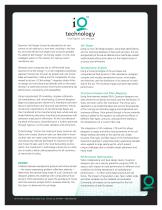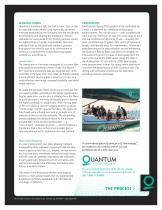
Catalog excerpts

Intelligent sail design. Quantum Sail Design Group has elevated the art and science of sail making to a new level, resulting in the fastest and most efficient sail shapes and structures possible. It’s called iQ Technology™ and simply stated, it is the most intelligent system in the industry for making custom membrane sails. Sail Shape Whereas some companies rely on off-the-shelf tools, Quantum’s iQ Technology™ is a fully integrated, proprietary approach honed over 20 years by people with vast knowledge and expertise in sailing and the complexities of engineered structures. iQ Technology™ integrates state-of-theart design and manufacturing methods with on-the-water testing in a systematic process that ensures outstanding sail performance, consistency and repeatability. Aerodynamic Analysis Using our own 3D design program, actual boat specifications, and our extensive database of boat and sail types, the size and geometry of the sail are defined and a mold shape created. Sophisticated editing tools allow for the highest levels of accuracy and refinement. Using a virtual prototype of the sail shape and computational fluid dynamic (CFD) calculations, designers compute and visualize aerodynamic forces, wind angles and velocities, and the distribution of air pressure on each side of the sail. The resulting images and data help predict performance. Structural Analysis and Fiber Mapping Using computerized 3D modeling, complex mathematical computations, and virtual testing, Quantum designers begin by analyzing each element of a membrane sail’s aerodynamic performance and structural requirements. Precise construction specifications of the refined sail design are then transferred to the manufacturing team where sails are made following meticulous manufacturing procedures with tolerances measured in millimeters. At the most demanding levels of the sport, sail performance is further optimized through rigorous, on-the-water validation and refinement. iQ Technology™ informs the making of every Quantum sail. Sailors who choose Quantum sails can take pride in knowing their sails are made using the same high standards and manufacturing methods developed for Quantum’s highend, Fusion M sails used in the most demanding environments. Our investment in technology is driven by our ambition to create a better sailing experience for all customers, at every level of sailing. Using finite element analysis (FEA), Quantum designers visualize where the sail bends and twists and the distribution of stress and strain within the membrane. The virtual sail is attached to a rig model that takes into account the properties of the running and standing rigging and longitudinal and transverse stiffness. Data gained through in-house materials testing is added to the equation to evaluate the effects of different fiber types, amounts, and placement leading to the development of a custom fiber map. The integration of 3D modeling, CFD and FEA allows designers to assess and refine varying elements of the sail design leading ultimately to the optimal size, shape, structure, fiber type, and fiber layout of the finished product. Quantum’s expertise in using these tools is particularly valuable when applied to large sailing yachts, which present unique challenges due to variable weight placement and heavy loads. Performance Optimization Design A balance between aerodynamic pressure and surface tension — the classic engineering problem called aero elasticity — determines the optimal flying shape of a sail. Quantum’s sail designers address this challenge with computational fluid dynamic (CFD) calculations to assess the aerodynamic forces and finite element analysis (FEA) to evaluate elasticity. The first step is to determine the sail shape. 061410 ©2010 Quantum Sail Design Group, Traverse City, MI 49648 • 1.888.QSDG.889 When collaborating with boat design teams, Quantum designers also use a velocity prediction program (VPP), to assess a sail’s impact on boat performance in different wind conditions by linking aerodynamic to hydrodynamic performance — in other words balancing hull and sail forces. The impact of rig position, rake, heel, rudder angle and other variables can be modeled and evaluated. Conversely, sail shapes can be optimized for the hull characte
Open the catalog to page 1
Quantum’s membrane sails are built in new, state-of-theart manufacturing centers using technically advanced methods developed by the company over the last decade for laminating and shaping the membrane. Written standards for every detail of the finishing process ensure the highest levels of quality and reliability. Quantum maintains links to industrial and academic partners throughout the world as part of its commitment to continuous improvement in manufacturing quality, consistency, and efficiency. The Quantum Racing TP52 program in the Audi MedCup Circuit is a platform for validating...
Open the catalog to page 2
STEP 1 - SAIL SHAPE Define geometry of the sail and create mold shape using 3D design program and extensive database of boat and sail types, t STEP 3 - STRUCTURAL ANALYSIS AND FIBER MAPPING Evaluate stresses and strains on the sail, rig and rigging with finite element analysis (FEA) and materials data to determine optimal flying shape and fiber layout. I technology STEP 6 - VERIFICATION Validate advancements in design technology and the iQ process through on-the-water testing. STEP 4 - OUTPUT DESIGN Adjust and refine all elements of the sail design and structure to achieve optimal shape,...
Open the catalog to page 3All Quantum Sails catalogs and brochures
-
MAINSAIL TRIM GUIDE
4 Pages
-
Cruising Precision Recut
6 Pages
-
Racing Precision Recut
6 Pages
-
Matte film brochure
4 Pages
-
cruising - woven
4 Pages
-
cruising
4 Pages
-
racing - spinnaker
4 Pages
-
racing
4 Pages
-
210
11 Pages
-
Beneteau First 36.7
1 Pages
-
Fusion_M
16 Pages
Archived catalogs
-
Cruising Sails
11 Pages
-
PROPER SAIL CARE
1 Pages















